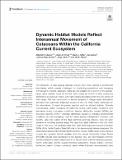Files in this item
Dynamic habitat models reflect interannual movement of cetaceans within the California current ecosystem
Item metadata
| dc.contributor.author | Becker, Elizabeth A. | |
| dc.contributor.author | Forney, Karin A. | |
| dc.contributor.author | Miller, David L. | |
| dc.contributor.author | Barlow, Jay | |
| dc.contributor.author | Rojas-Bracho, Lorenzo | |
| dc.contributor.author | Urbán R, Jorge | |
| dc.contributor.author | Moore, Jeff E. | |
| dc.date.accessioned | 2022-05-18T15:30:27Z | |
| dc.date.available | 2022-05-18T15:30:27Z | |
| dc.date.issued | 2022-05-10 | |
| dc.identifier | 279616184 | |
| dc.identifier | 287c609d-248e-4a41-86ff-11f3c1ebfd8d | |
| dc.identifier | 85130702849 | |
| dc.identifier | 000802267900001 | |
| dc.identifier.citation | Becker , E A , Forney , K A , Miller , D L , Barlow , J , Rojas-Bracho , L , Urbán R , J & Moore , J E 2022 , ' Dynamic habitat models reflect interannual movement of cetaceans within the California current ecosystem ' , Frontiers in Marine Science , vol. 9 , 829523 . https://doi.org/10.3389/fmars.2022.829523 | en |
| dc.identifier.issn | 2296-7745 | |
| dc.identifier.other | Bibtex: 10.3389/fmars.2022.829523 | |
| dc.identifier.uri | https://hdl.handle.net/10023/25405 | |
| dc.description | This modeling project was funded by the Navy, Commander, U.S. Pacific Fleet (U.S. Navy), the Bureau of Ocean Energy Management (BOEM), and by the National Oceanic and Atmospheric Administration (NOAA), National Marine Fisheries Service (NMFS), Southwest Fisheries Science Center (SWFSC). The 2018 survey was conducted as part of the Pacific Marine Assessment Program for Protected Species (PacMAPPS), a collaborative effort between NOAA Fisheries, the U.S. Navy, and BOEM to collect data necessary to produce updated abundance estimates for cetaceans in the CCE study area. BOEM funding was provided via Interagency Agreement (IAA) M17PG00025, and Navy funding via IAA N0007018MP4C560, under the Mexican permit SEMARNAT/SGPA/DGVS/013212/18. The methods used to derive uncertainty estimates were developed as part of “DenMod: Working Group for the Advancement of Marine Species Density Surface Modeling” funded by OPNAV N45 and the SURTASS LFA Settlement Agreement, and managed by the U.S. Navy’s Living Marine Resources (LMR) program under Contract No. N39430-17-C-1982. Other permits included INEGI: Oficio núm. 400./331/2018, INEGI.GMA 1.03 SAGARPA de Oficio B00.02.04.1530/2018 NMFS Permit No. 19091. | en |
| dc.description.abstract | The distribution of wide-ranging cetacean species often cross national or jurisdictional boundaries, which creates challenges for monitoring populations and managing anthropogenic impacts, especially if data are only available for a portion of the species’ range. Many species found off the U.S. West Coast are known to have continuous distributions into Mexican waters, with highly variable abundance within the U.S. portion of their range. This has contributed to annual variability in design-based abundance estimates from systematic shipboard surveys off the U.S. West Coast, particularly for the abundance of warm temperate species such as striped dolphin, Stenella coeruleoalba, which increases off California during warm-water conditions and decreases during cool-water conditions. Species distribution models (SDMs) can accurately describe shifts in cetacean distribution caused by changing environmental conditions, and are increasingly used for marine species management. However, until recently, data from waters off the Baja California peninsula, México, have not been available for modeling species ranges that span from Baja California to the U.S. West Coast. In this study, we combined data from 1992–2018 shipboard surveys to develop SDMs off the Pacific Coast of Baja California for ten taxonomically diverse cetaceans. We used a Generalized Additive Modeling framework to develop SDMs based on line-transect surveys and dynamic habitat variables from the Hybrid Coordinate Ocean Model (HYCOM). Models were developed for ten species: long- and short-beaked common dolphins (Delphinus delphis delphis and D. d. bairdii), Risso’s dolphin (Grampus griseus), Pacific white-sided dolphin (Lagenorhynchus obliquidens), striped dolphin, common bottlenose dolphin (Tursiops truncatus), sperm whale (Physeter macrocephalus), blue whale (Balaenoptera musculus), fin whale (B. physalus), and humpback whale (Megaptera novaeangliae). The SDMs provide the first fine-scale (approximately 9 x 9 km grid) estimates of average species density and abundance, including spatially-explicit measures of uncertainty, for waters off the Baja California peninsula. Results provide novel insights into cetacean ecology in this region as well as quantitative spatial data for the assessment and mitigation of anthropogenic impacts. | |
| dc.format.extent | 21 | |
| dc.format.extent | 15100111 | |
| dc.language.iso | eng | |
| dc.relation.ispartof | Frontiers in Marine Science | en |
| dc.subject | Baja California | en |
| dc.subject | Cetacean | en |
| dc.subject | Generalized additive model | en |
| dc.subject | Habitat model | en |
| dc.subject | Species distribution model | en |
| dc.subject | Souther California Current | en |
| dc.subject | GC Oceanography | en |
| dc.subject | QA Mathematics | en |
| dc.subject | 3rd-DAS | en |
| dc.subject | SDG 14 - Life Below Water | en |
| dc.subject.lcc | GC | en |
| dc.subject.lcc | QA | en |
| dc.title | Dynamic habitat models reflect interannual movement of cetaceans within the California current ecosystem | en |
| dc.type | Journal article | en |
| dc.contributor.institution | University of St Andrews. School of Mathematics and Statistics | en |
| dc.identifier.doi | https://doi.org/10.3389/fmars.2022.829523 | |
| dc.description.status | Peer reviewed | en |
This item appears in the following Collection(s)
Items in the St Andrews Research Repository are protected by copyright, with all rights reserved, unless otherwise indicated.

